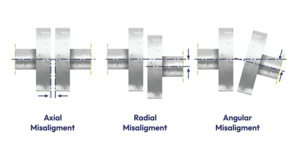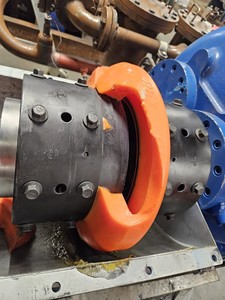
 |
Charlotte Stonestreet
Managing Editor |
| Home> | POWER TRANSMISSION | >Couplings | >Overcoming coupling failure and maximising productivity |
Overcoming coupling failure and maximising productivity
12 August 2025
Jason Buck outlines three key considerations for minimising coupling failure and maximising performance potential
SPEND ANY time in the world of couplings and you will know that there are a lot to choose from! With over twenty widely used coupling types and many more sub-variants and bespoke solutions, the ‘right’ coupling will be the one that meets that machine, environment or industry’s specific needs. Over my years working in supplying best-fit couplings for a wide range of applications however, there are three considerations that I see as priorities when looking to promote coupling reliability and longevity.
Does it have a sufficient torque rating and operate within misalignment parameters?
One of the most common reasons for coupling failure that I see in my working day are couplings that have not been selected with sufficient torque rating. By not identifying a suitable coupling that can withstand the torque being transferred through the drive, issues can occur.
Also, although couplings can help manage shaft misalignment issues between the motor and driven machine, if they aren’t properly selected this can lead to premature failure, increased bearing and seal loads and reduced machine accuracy. All these things will, over time, lead to a situation of unplanned maintenance, potential damage to connected equipment and costly downtime. It can also be costly to replace a damaged coupling, and this is an unnecessary and unwanted expense if the proper coupling selection procedures are not followed.
In an ideal world shafts would be perfectly aligned but that is rarely the case. That is why flexible couplings that resolve angular and radial misalignment issues and axial movement are so popular. However, whether it is a jaw, beam, disc gear or grid coupling, if the misalignment parameters of the coupling have been exceeded, then issues will occur.
So, the second common reason for coupling failure that I see is the under-estimation of the degree of misalignment. This creates loads that surpass the coupling’s specifications, causing it to wear at an accelerated rate. The result is bearing and shaft wear, noise, vibration and premature coupling and machine failure. If the shaft misalignment is greater than the coupling’s operational limits, then it will need to be realigned before coupling installation is undertaken, otherwise repeat failures and more production downtime will be the result.
Is it the right coupling for the right application?
The third area of premature coupling failure that I deal with a lot is due to the wrong coupling being used in the wrong application. Understanding application requirements is key to choosing the right coupling solution, as well as the environmental conditions it will be exposed to. Several criteria must be considered when deciding on a type of coupling, including the type of application, misalignment, stiffness, inertia, RPM, shaft mounting, environmental factors, space limitations, service factors, and cost.
Also, mistakes in coupling selection can be exacerbated by a lack of consideration for torsional compliance (or windup), backlash, not considering the dampening levels required, or underestimating the torque for an application. Taking torque as an example, the maximum instantaneous torque for an application needs to be considered, in addition to the steady-state torque. Flexible couplings have different static torque ratings depending on the design type. For example, a double disc coupling will typically offer a 15-20% higher static torque rating than an identically sized Oldham coupling with an acetal disc. It is therefore important that each criterion impacting coupling choice must be individually assessed to ensure that the end solution is fit for purpose and the process must also be repeated for any change in conditions throughout the application’s lifecycle.
However, the world of couplings is vast, and it is difficult to keep up to speed with the variety of options available and which would be the best fit for each application. As a supplier of a wide range of manufacturers couplings, from Falk and KTR to Rexnord, Flender, Centa and Protorque, a lot of our team’s time is spent running calculations across manufacturers’ products. When we do this, we are assessing the application’s power, speed and shaft size requirements, as well as the driving and driven equipment, the shaft gap, room envelope size and any shock loading issues. We also need to assess environmental factors, availability and price.
Although the right choice of coupling can be complex, by looking out for under-torquing and over-misalignment and making the most of coupling manufacturers’ and suppliers’ expertise, premature coupling failure can be minimised, and longevity maximised.
Jason Buck is couplings and drives product manager at Acorn Industrial Services
Overcoming failure
When a unique coupling failed, an established pump, motor, and gearbox repairer needed a fast and effective solution to stay ahead of their competitors. Acorn collaborated closely with the coupling manufacturer and the customer to modify a double engagement gear coupling to better suit their specific needs.
The key adjustments included the shortening of the coupling hubs to create more maintenance space, improving accessibility for future servicing, and the provision of technical drawings and pricing support to ensure full clarity and confidence in the solution. Through careful engineering and strategic communication, the right coupling was delivered on time, preventing further damage and allowing our client to resume their work and continue serving their clients
- No related articles listed






















